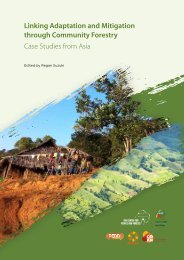Desktop Study on - Regional Climate Change Adaptation ...
Desktop Study on - Regional Climate Change Adaptation ...
Desktop Study on - Regional Climate Change Adaptation ...
You also want an ePaper? Increase the reach of your titles
YUMPU automatically turns print PDFs into web optimized ePapers that Google loves.
Assessment of Capacity Gaps and Needs of South East Asia Countries<br />
in Addressing Impacts, Vulnerability and Adaptati<strong>on</strong> to <strong>Climate</strong> Variability and <strong>Climate</strong> <strong>Change</strong><br />
Figure 46: Percentage of people affected<br />
due to top 10 natural disasters<br />
1900-2010<br />
draining through nine deltas into the Indian Ocean.<br />
The Ayeyarwady delta regi<strong>on</strong> is nowadays observed<br />
to be affected from increased frequency of floods<br />
and cycl<strong>on</strong>es due to climate change (Khin Thein<br />
Htwe, 2009).<br />
Storm 39%<br />
Flood 61%<br />
Floods generally occur during the southwest<br />
M<strong>on</strong>so<strong>on</strong> seas<strong>on</strong> of June through October due to<br />
intense rainfall that is resulted from the low pressure<br />
waves superimposed <strong>on</strong> the general m<strong>on</strong>so<strong>on</strong>.<br />
Particularly in the lower Ayeyarwady river basin, the<br />
main cause of flooding is tropical cycl<strong>on</strong>e. Tropical<br />
cycl<strong>on</strong>es are at times very destructive due to the<br />
three main c<strong>on</strong>stituents: str<strong>on</strong>g winds (above 150<br />
km/hour), heavy rainfall (above 30 to 40 cm in 24<br />
hours), and storm surges (above 4 to 5 m).<br />
Figure 47: Percentage of people affected<br />
due to total natural disasters<br />
1900-2010<br />
Storm 60%<br />
Wildfire 1%<br />
Flood 39%<br />
Figure 48: Percentage of damage (US$)<br />
due to total natural disasters<br />
1900-2010<br />
Wildfire 0%<br />
Flood 3%<br />
Earthquake 11%<br />
Flood incidents could become worse in Myanmar<br />
given the projected changes <strong>on</strong> intense rainfall,<br />
temperature and cycl<strong>on</strong>e intensity in Myanmar and<br />
around the South-East Asian regi<strong>on</strong>. As menti<strong>on</strong>ed<br />
earlier, rainfall intensity as well as the amount<br />
of rainfall caused by an extreme storm event are<br />
projected to increase (World Bank, 2009c). In<br />
additi<strong>on</strong>, according to the fourth IPCC report with<br />
regi<strong>on</strong>al specifics in projected climatic changes,<br />
annual precipitati<strong>on</strong> is projected to increase al<strong>on</strong>g<br />
with mean winter and summer precipitati<strong>on</strong> in<br />
South-East Asia for the three times slices, namely<br />
2020s, 2050s and 2080s (Lal, 2003, Rupa Kumar<br />
et al., 2003, Kw<strong>on</strong> et al., 2004, Boo et al., 2004,<br />
Japan Meteorological Agency, 2005, Kurihara<br />
et al., 2005 cited in Parry et al., 2007). Also, an<br />
increase in occurrence of extreme weather events<br />
including intense precipitati<strong>on</strong> is expected (Emori<br />
et al., 2000, Kato et al., 2000, Sato, 2000, Lal, 2003,<br />
Rupa Kumar et al., 2003, Hasumi and Emori, 2004,<br />
Ichikawa, 2004, May, 2004b, Walsh, 2004, Japan<br />
Meteorological Agency, 2005, Kurihara et al., 2005<br />
cited in Parry et al., 2007) al<strong>on</strong>g with an increase<br />
in the inter-annual variability of daily precipitati<strong>on</strong><br />
during the summer m<strong>on</strong>so<strong>on</strong> (Lal et al., 2000,<br />
May, 2004a, Giorgi and Bi, 2005 cited in Parry et<br />
al., 2007). Furthermore, South-East Asia will face<br />
gradual temperature rise with a similar level to<br />
the global mean warming over the same time slices<br />
(Ruosteenoja et al., 2003, Christensen et al., 2007<br />
cited in Parry et al., 2007). Regarding tropical<br />
cycl<strong>on</strong>e intensities, the IPCC Fourth Assessment<br />
Report also indicates an increase of 10 to 20% al<strong>on</strong>g<br />
with a rise in sea-surface temperature of 2 to 4°C.<br />
As a result of abovementi<strong>on</strong>ed projected changes <strong>on</strong><br />
intense rainfall, temperature and cycl<strong>on</strong>e intensity<br />
in Myanmar and over South-East Asia, the frequency<br />
127

















